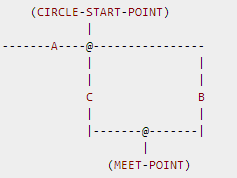Given a linked list, return the node where the cycle begins. If there is no cycle, return null.
Note: Do not modify the linked list.
Follow up:
Can you solve it without using extra space?
这个题还是蛮考验数学推理的,不过在前一个题的基础上还是能推出结果的。这是英文一段解释,非常有帮助。
First Step: Assume the first pointer runs from head at a speed of 1-by-1 step, as S, and the second pointer runs at a speed of 2-by-2 step, as 2S, then two pointers will meet at MEET-POINT, using the same time. Define outer loop is A, the distance from CIRCLE-START-POINT to MEET-POINT is B, and the distance from MEET-POINT to CIRCLE-START-POINT is C (Apparently, C=loop-B), then (n*loop+a+b)/2S = (a+b)/S, n=1,2,3,4,5,....
Converting that equation can get A/S=nloop/S-B/S. Since C=loop-B, get A/S = ((n-1)loop+C)/S.
That means, as second step, assuming a pointer running from head and another pointer running from MEET-POINT both at a speed S will meet at CIRCLE-START-POINT;

代码如下:
1 public class Solution { 2 public ListNode detectCycle(ListNode head) { 3 if(head==null || head.next==null) return null; 4 ListNode pointer1 = head; 5 ListNode pointer2 = head; 6 7 while(pointer1!=null && pointer2!=null){ 8 pointer1 = pointer1.next; 9 if(pointer2.next==null) return null; 10 pointer2 = pointer2.next.next; 11 12 if(pointer1==pointer2) break; 13 } 14 if(pointer1==null || pointer2==null) return null; 15 16 pointer1 = head; 17 while(pointer1 != pointer2){ 18 pointer1 = pointer1.next; 19 pointer2 = pointer2.next; 20 } 21 return pointer1; 22 } 23 }